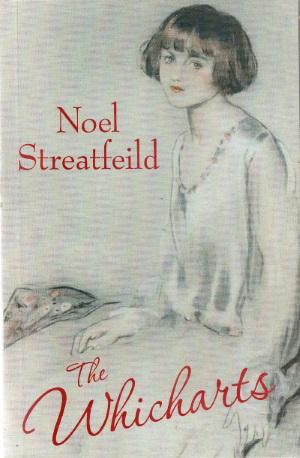Book review by George S: I should probably start this review with a trigger warning. It may cause disquiet and consternation to anyone for whom Ballet Shoes was an essential and much-loved part of their childhood.

The Whicharts is Noel Streatfeild’s first novel. It starts with the story of Rose, a young woman in Edwardian England, seduced by a rather dashing soldier, a Brigadier. Her family disown her. He sets her up as his mistress in a house in the Cromwell Road, and when he is tired of her does the decent thing by leaving her the house and an income of five hundred a year. She is desolated at losing him, but a couple of years later receives a call for help. His next mistress is pregnant, and dare not go home to her parents. Will Rose lok after her? Rose does, and when a daughter is born, Rose agrees to adopt it. That’s Mamie. A little later the Brigadier has an affair with a Russian. This produces a daughter called Tania. Once more Rose takes her in. She says no more, but come the First World War, the Brigadier has an affair with a dancer. She dies in childbirth, and Rose takes in a third baby, called Daisy.
The Brigadier dies during the war – of stress and overwork, not in action – and Rose, together with the Nannie the Brigadier has provided, has three girls to look after. The investments the Brigadier made now bring in a smaller income than the original five hundred, and money is tight. Rose takes in lodgers, one of whom is a dancing teacher. She explains that Mamie is old enough to earn money in the children’s chorus of a pantomime. Those of you who know Ballet Shoes will see where this is heading, especially when I say that the middle daughter, Tania, has a love of machines and aeroplanes, and the youngest, Daisy, is a born ballerina.
When the girls begin school, Rose realises that they need a surname – they can’t use hers or the Brigadiers. It’s the baby, Daisy who says they should be known by their father’s name.
Rose was puzzled.
‘What name, darling?’
‘Whichart, of course.’
Rose must have looked hopelessly fogged, because Mamie said kindly, as one helping an imbecile:
‘Our father Whichart.’
‘In heaven, you know,’ Tania added.
So they become the Whicharts.
It’s all a great deal seedier than Ballet Shoes. The dancing school is grubby, and Madame, in charge of it, is eccentric, but no genius. She is good, though, at finding girls jobs in downmarket shows.
In Ballet Shoes, Pauline, the eldest girl, blossoms as a Shakespearean actress. Mamie is very different. She sees working on the stage as merely a route to money, and to men (the source of money). She is innocent at first, and when a manager takes an interest in her, she finds herself out of her depth.
She thought: ‘Surely it must have been an accident, he couldn’t have meant to touch me quite like that. Not there!’
There is an anxious couple of pages soon afterwards, when she is waiting anxiously for her period. All is well, but after this her attitude to men changes. Her show business career becomes a way of meeting men who will give her nice presents, and offer to install her in a flat of her own. When I used to read Ballet Shoes to my daughter (and I think I read it to her three times between when she was six and when she was about ten) Pauline was my favorite among the sisters. It came as a bit of a shock to find that in the original she was no better than she should be.
Even more of a shock is that in this version Rose, the guardian, dies, and the three girls are left to support themselves.
Daisy is the born dancer, but when her grandparents, a very respectable couple from Surbiton, find her, she is only too happy to give up the stage in return for a close family and domesticity.
Tania is the one who hates performing, but has to continue, just to earn money. There is a very funny sequence when she is acting and dancing with a highbrow Shakespearian company touring the provinces. The depiction of the actor-manager is very sharp, and you suspect it may have been drawn from life.
Was it some astute publisher who saw the germ of a brilliant children’s book in this novel when it was first published? Noel Streatfeild wanted to be a serious novelist for adults, but her books were not successful – not even Parson’s Nine, which I think is marvellous, and which I have written about briefly elsewhere. She took to writing children’s books, and also lighter fiction under the pseudonym Susan Scarlett. Some of the Scarletts have been republished by the excellent Greyladies Books.
Ever since Ballet Shoes in 1936 her books have thrilled readers by presenting the enchantments of show business. This is a very disenchanted view of the theatrical world (even though it does offer something of a fairytale ending).
The book quickly went out of print in the thirties (Was it hurried out of the way when Ballet Shoes appeared in 1936?) The cover at the top of this review is that of a 2010 reprint by Margin Notes Books, but that now seems to be out of print again.
I enjoyed it immensely. Maybe I should make a confession. For the reading Group we are supposed to tackle each month a book that we had not previously read. I broke the rule this month by returning to this, because I like it so much. Noel Streatfeild is so very good at describing families.
So it’s highly recommended – but maybe you should keep it out of the hands of nine-year-old Ballet Shoes fans, who might be rather disconcerted by it.

